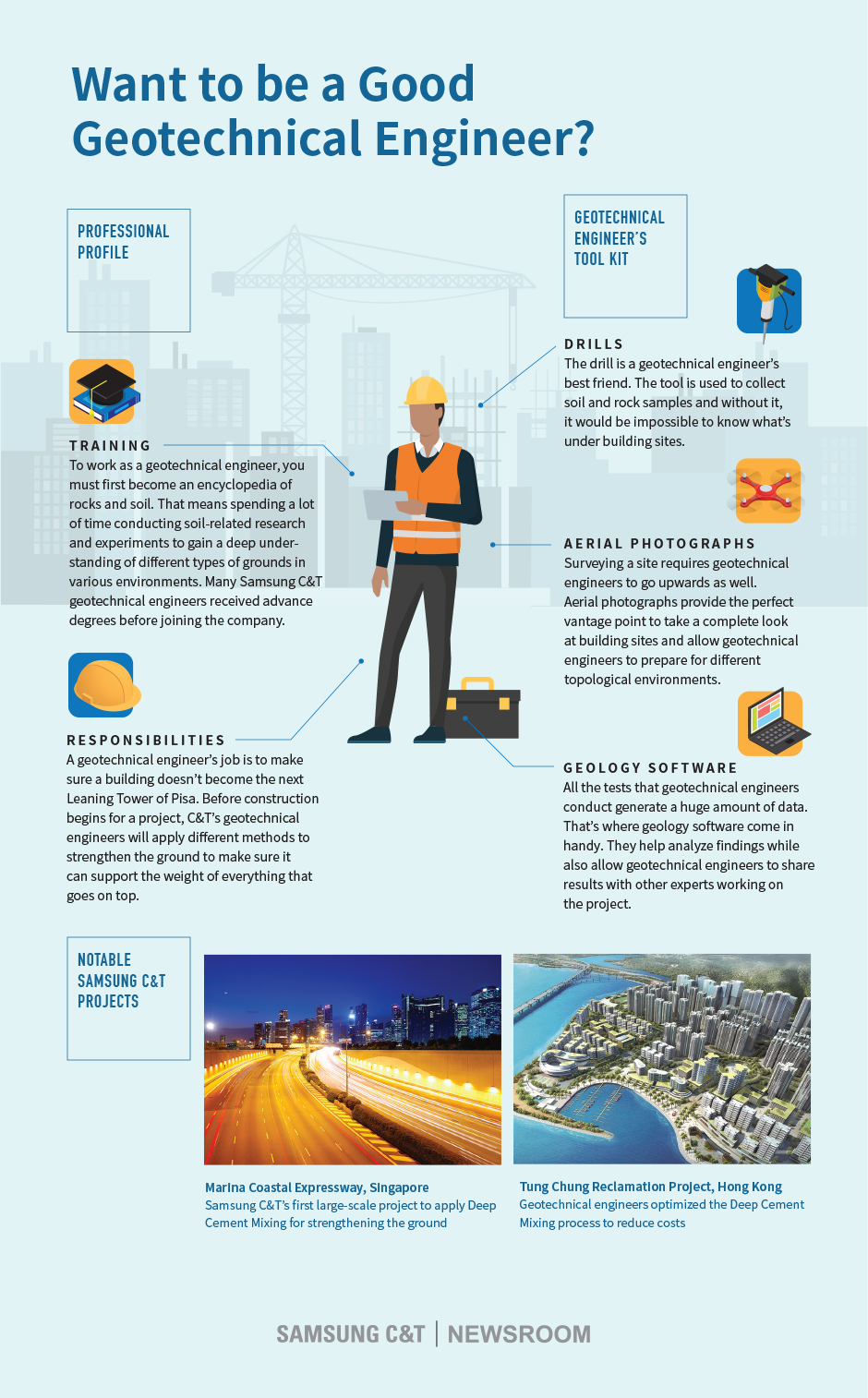Facts About Geotheta Uncovered
Facts About Geotheta Uncovered
Blog Article
Geotheta for Dummies
Table of ContentsTop Guidelines Of GeothetaEverything about GeothetaGeotheta Fundamentals ExplainedGet This Report about GeothetaSome Known Details About Geotheta

They perform website investigations, accumulate samples, do laboratory tests, and evaluate information to review the viability of the ground for construction jobs - Geo Tech Engineer. Based upon their findings, geotechnical engineers offer suggestions for foundation style, incline security, retaining frameworks, and reduction of geotechnical hazards. They work together with various other specialists, such as architects, architectural designers, and building and construction teams, to ensure that geotechnical factors to consider are incorporated right into the overall project design and implementation
By analyzing the actions and homes of dirt and rock, they can recognize possible geotechnical dangers such as landslides, dirt settlement, or incline instability. Their competence helps avoid failures or mishaps that might endanger lives and building. Below are some thorough tasks and duties of a geotechnical designer: Website Examination: Geotechnical designers conduct site investigations to collect data on subsurface problems.
They interpret the data to comprehend the properties and behavior of the dirt and rock, including their strength, leaks in the structure, compaction qualities, and groundwater conditions. Geotechnical Analysis and Style: Geotechnical engineers assess the information gathered during website examinations to evaluate the stability and suitability of the website for building and construction projects. They perform geotechnical computations and modeling to examine factors such as birthing ability, negotiation, slope stability, lateral earth pressures, and groundwater flow.
The Main Principles Of Geotheta
Foundation Layout: Geotechnical designers play a critical duty in designing foundations that can safely sustain the intended framework. They examine the dirt problems and lots demands to determine the appropriate foundation type, such as superficial structures (e.g., grounds), deep structures (e.g (https://geotheta-46958753.hubspotpagebuilder.com/blog/unlocking-the-future-with-top-notch-geotechnical-engineers-at-geotheta)., piles), or specialized methods like soil enhancement. They consider elements such as settlement restrictions, bearing capability, and soil-structure interaction to develop optimum foundation layouts
They review building strategies, monitor website tasks, and conduct area examinations to confirm that the layout suggestions are adhered to. If unanticipated geotechnical problems emerge, they evaluate the scenario and supply suggestions for remediation or changes to the layout. Risk Analysis and Reduction: Geotechnical designers evaluate geotechnical dangers and dangers connected with the project site, such as landslides, liquefaction, or dirt disintegration.

Collaboration and Communication: Geotechnical engineers function very closely with various other experts associated with a job, such as architects, structural designers, and construction teams. Effective communication and collaboration are necessary to incorporate geotechnical considerations right into the total job layout and building process. Geotechnical designers offer technical proficiency, response questions, and guarantee that geotechnical requirements are met.
Our Geotheta PDFs
Right here are some kinds of geotechnical designers: Structure Engineer: Structure designers focus on designing and assessing structures for frameworks. They examine the dirt problems, lots requirements, and website characteristics to figure out the most appropriate structure type and design, such as superficial foundations, deep structures, or specialized methods like pile structures.
They evaluate the aspects influencing incline stability, such as soil residential or commercial properties, groundwater problems, and incline geometry, and create methods to stop slope failings and reduce threats. Earthquake Engineer: Earthquake engineers specialize in assessing and creating frameworks to withstand seismic pressures. They analyze the seismic threat of a site, evaluate dirt liquefaction capacity, and establish seismic style requirements to guarantee the safety and strength of structures throughout quakes.
They execute field testing, collect samples, and examine the gathered information to define the soil residential or commercial properties, geologic developments, and groundwater problems at a website. Geotechnical Instrumentation Designer: Geotechnical instrumentation engineers concentrate on tracking and gauging the behavior of dirt, rock, and frameworks. They set up and preserve instrumentation systems that keep an eye on variables such as dirt negotiation, groundwater levels, incline activities, and structural variations to assess performance and give early warnings of potential issues.
What Does Geotheta Do?
They conduct tests such as triaxial tests, consolidation examinations, direct shear tests, and permeability examinations to gather data for geotechnical analysis and style. Geosynthetics Designer: Geosynthetics designers concentrate on the design and application of geosynthetic materials, such as geotextiles, geogrids, and geomembranes. They use these products to boost look at these guys dirt stability, strengthen inclines, give water drainage options, and control erosion.
They often tend to be investigatory people, which means they're intellectual, introspective, and inquisitive. They are curious, methodical, logical, analytical, and logical. A few of them are also social, indicating they're kind, charitable, cooperative, individual, caring, practical, empathetic, sensible, and friendly. Does this noise like you? Take our cost-free job examination to learn if geotechnical engineer is among your top job suits.
In the workplace setting, geotechnical engineers use specialized software application tools to perform computations, develop designs, and examine information. They prepare reports, review project requirements, connect with clients and staff member, and coordinate project tasks. The office setup gives a favorable setting for study, evaluation, and collaboration with various other professionals included in the task.
An Unbiased View of Geotheta
They often go to task sites to conduct website examinations, examine geotechnical conditions, and gather information for evaluation. These brows through include traveling to different locations, often in remote or tough terrains. Geotechnical designers might perform dirt tasting, conduct tests, and screen building and construction activities to ensure that the geotechnical facets of the job are being applied properly.
Geotechnical designers likewise function in specialized geotechnical labs. Geotechnical lab designers function thoroughly in these atmospheres, handling screening devices, running tools, and taping data.
Report this page